-
Spoonie’s Journey: A Tale of Survival and Migration
As the proud author and illustrator, I’m thrilled to share my long overdue piece of heart with you—Spoonie’s Journey.
Spoonie’s Journey is a reflection of the real challenges faced by the spoon-billed sandpiper—a species teetering on the brink of extinction. As we delve into Spoonie’s sojourn, we’re reminded of the delicate balance of nature and our responsibility to preserve habitats, ensuring the survival of these remarkable creatures and their extraordinary migratory journeys.

In the heart of the vast tundra of northeast Russia, a tiny spoon-billed sandpiper named Spoonie is born on a warm summer’s day. With a beak shaped like a spoon, Spoonie navigates the soft muddy land, scooping up spiders, flies, and mosquitoes—the perfect feast for this little adventurer.
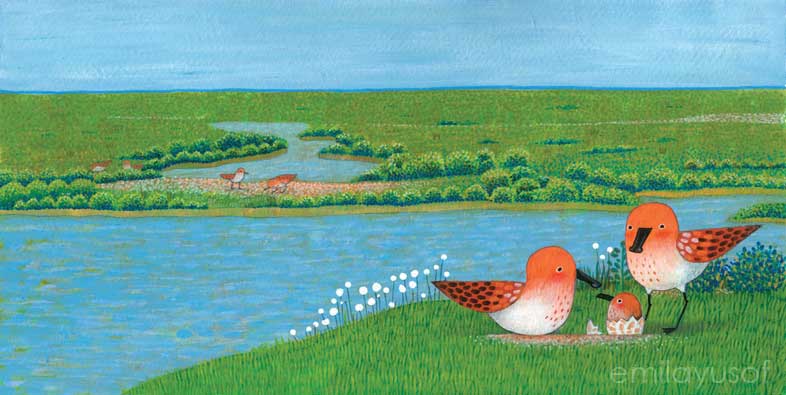
As the days grow colder, Spoonie joins his parents to embark on a mesmerizing migration, soaring over lands and oceans. They stopped at Yubu Island in Japan and sunny wetlands of Malaysia before flying to Australia and the Yellow Sea in China, before finally reaching the beloved tundra.
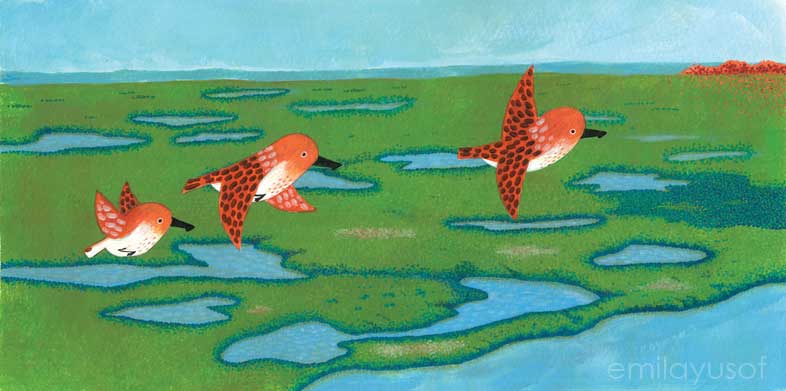
SPOONIE’S JOURNEY
ISBN 9789672384519
Publisher: Oyez!Books
Size: 21 cm x 22 cm
Year: 2022 -
Basic Guide to Crafting Captivating Illustrations for Children’s Picture Books
Creating illustrations for children’s picture books is a delightful blend of creativity, storytelling, and visual artistry. To craft images that captivate young readers, consider the following key elements:
1. Vibrant Color Palette: Choose bright and appealing colours that resonate with the target age group, evoking emotions and creating a lively atmosphere.
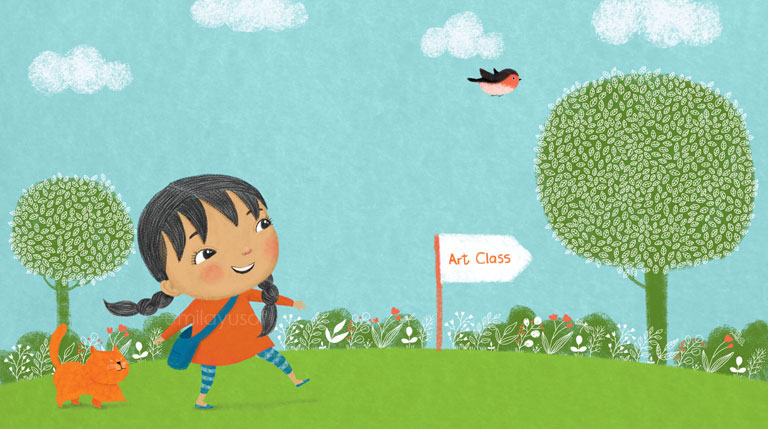
Dina’s Art Class, published by Oyez!Books 2. Character Design: Develop characters with distinctive features, expressions, and relatable traits to foster a connection with young readers.

From left: Jingga and Dina (Dina’s Art Class, Oyez!Books), Jep (Umaral, Oyez!Books), Pipa, Wigel & Uncle Spruce (Pipa Gadis Kertas, soon DBP). 3. Consistent Style: Maintain a consistent illustration style throughout the book to provide a cohesive and memorable visual experience.
4. Scale and Perspective: Experiment with varying scales and perspectives to add visual interest and dynamic elements to the illustrations.
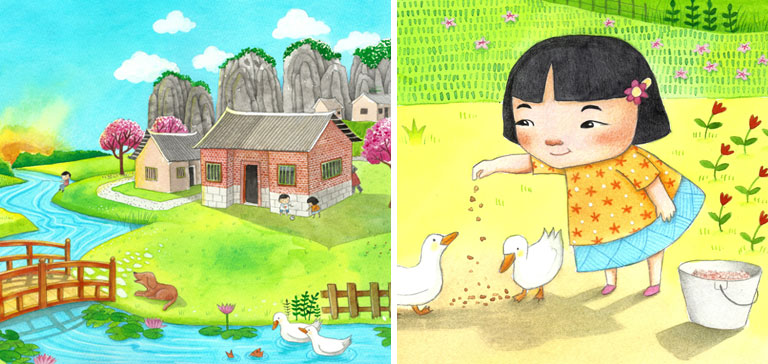
Over The Bridge (Author: Tang Su Lan, Illustrator: Emila Yusof) Hunan Juvenile & Children’s Publishing House) 5. Emotional Resonance: Infuse characters and scenes with emotions to create a deeper connection with young readers.
6. Interactive Elements: Integrate interactive or hidden details that encourage reader engagement, making the experience more enjoyable.
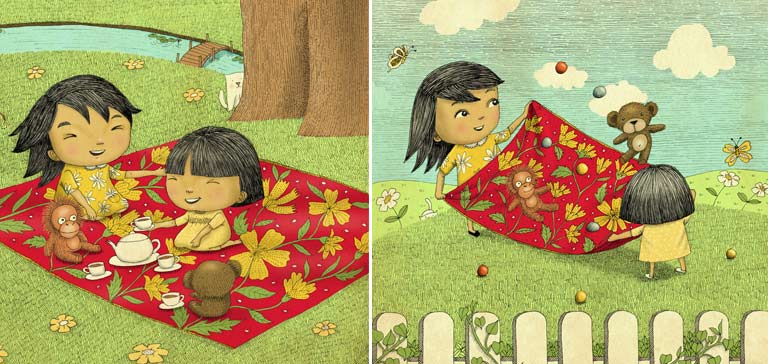
Notice the cat? It appears on most pages. Two Sisters, One Sarong (Author: Lorraine Yoong, Precious Pages Resources) 7. Cultural Sensitivity: Represent diverse cultures accurately and respectfully in illustrations to promote inclusivity.

Wu Zetian, China and Nawang Wulan, Indonesia (Legendary Princesses of the World, unpublished) 8. Typography Integration: Explore ways to integrate typography creatively with illustrations, enhancing the overall visual appeal.
9. Symbolism and Themes: Include subtle symbolism or thematic elements that enhance the story’s underlying message.
10. Dynamic Poses: Experiment with dynamic poses for characters to convey energy and movement, keeping the visual storytelling lively.
11. Humor and Playfulness: Infuse a sense of humour and playfulness into the illustrations, adding whimsical details for added joy.
12. Visual Consistency Across Series: Maintain visual consistency if the picture book is part of a series, building a recognizable brand for readers.
13. Imagination and Creativity: Foster imagination and creativity through illustrations that spark young readers’ imaginative thoughts.
14. Illustration Techniques: Explore a variety of illustration techniques to add richness and visual interest to your artwork. Experiment with techniques such as watercolour, digital illustration, mixed media, or hand-drawn elements. Each technique brings its unique qualities, allowing you to create a diverse visual experience within the pages of the picture book. Consider how different techniques can enhance specific aspects of the story or evoke particular emotions, providing a dynamic and engaging visual journey for young readers.
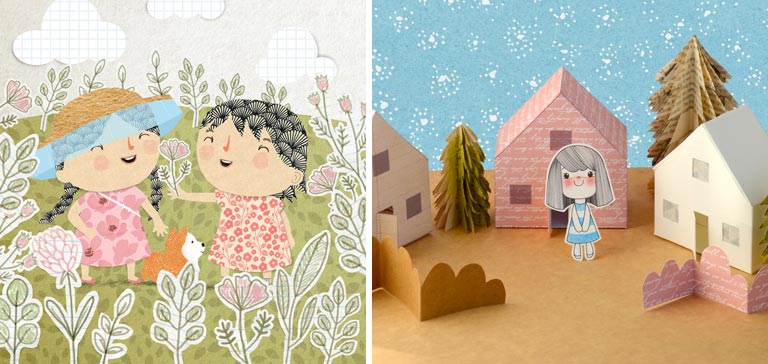
Left: Digital Collage with scanned and vector illustrations, from Grandma’s Flowering Tea (Oyez!Books). Right: Paper-based objects in the Diorama setting, captured with camera from Pipa Gadis Kertas (soon by DBP) 15. Adaptability for Different Formats: Ensure illustrations remain impactful and clear in various formats, including e-books or interactive platforms.
16. Educational Opportunities: Integrate educational elements into illustrations where applicable, creating hidden details for young readers to learn from.
17. Inspiration from Everyday Life: Draw inspiration from everyday life, nature, and the target audience’s experiences to infuse authenticity into the illustrations.
18. Testing with the Audience: Test illustrations with the target audience to gather insights and ensure the visual elements resonate effectively.
In essence, creating illustrations for children’s picture books is a dynamic and imaginative process. Embrace experimentation, stay open to feedback, and enjoy the journey of bringing stories to life through visually captivating art. I will add more of my illustrations when time permits.
-
We’re not just individuals; we’re cosmic in our own right.
“We’re like universes, you know?” she remarked.
He raised an eyebrow, intrigued. “How so?”
“Ever heard of Rumi? Rumi said “the entire universe is inside you. Stop acting so small. You are the universe in ecstatic motion,” she explained.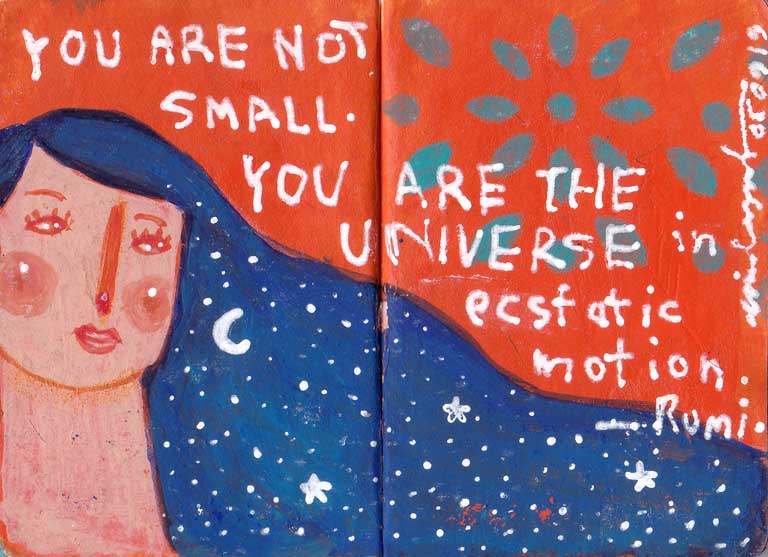
You are the Universe in Tiny Sketchbook for Tiny Sketchbook Project, 2020 organised by Brooklyn Art Library. “
-
The Door
[Note: I wrote this on 9 July 2020. Found it in the draft folder. I LMAO alone while publishing this story now.]
When I saw the ad, I didn’t think twice. I clicked the “Buy Now” button and made the payment. So, after a week, J&T Express came honking at my door; the package had arrived from Japan. I opened the package and placed it in my studio, just beside the main door.
A day after I received the package, I packed my bag and went travelling around the world. I brought with me a whole load of facial masks and gloves too. During this pandemic outbreak, one has to think about personal health and safety.
My first destination was Venice, due to the printmaking workshop I paid for early this year. I learned a lot in the workshop and stayed there for a week to cover the duration of the full course.
After buying some printmaking tools, I then went on to the next destination: Positano. Later on, I visited Syracuse, Palermo, and Sardinia Island. These cities were on my list just because.
Next on the list were the cities of literature that I had been longing to visit: Amherst. Being a fan of Emily Dickinson, I included The Emily Dickinson Museum on my bucket list. The museum is a merged property of two houses the poet called home, set on three acres of natural beauty that inspired much of her work.
So when I posted my photos on Instagram, having breakfast in Dublin, lunch in Paris, and dinner in Zagreb, people were wondering and thought that I superimposed my photos. Well, I did not. I bought the infamous Dokodemo Door—remember the package delivered by J&T Express?
Being an avid traveller, this door is very important. You see, the door is magical. It can fit in my bag and will become bigger in times of need. There are only two authentic and genuine doors in the world; one of which is owned by Doraemon.

Somewhere in Vatican City, 2016 -
Pengembaraan Aidin dan Aida Melihat Keajaiban Hutan, tulisan Haizan Runsah
Tahun ini saya mengambil satu sahaja kerja ilustrasi dari penulis. Setahun satu itu cukup buat saya kerana kerja-kerja melukis projek peribadi memang banyak—dari lukisan seni halus ke ilustrasi buku sendiri. Pelawaan dari Tuan Haizan saya tidak dapat tolak kerana temanya hutan. Saya suka hutan.
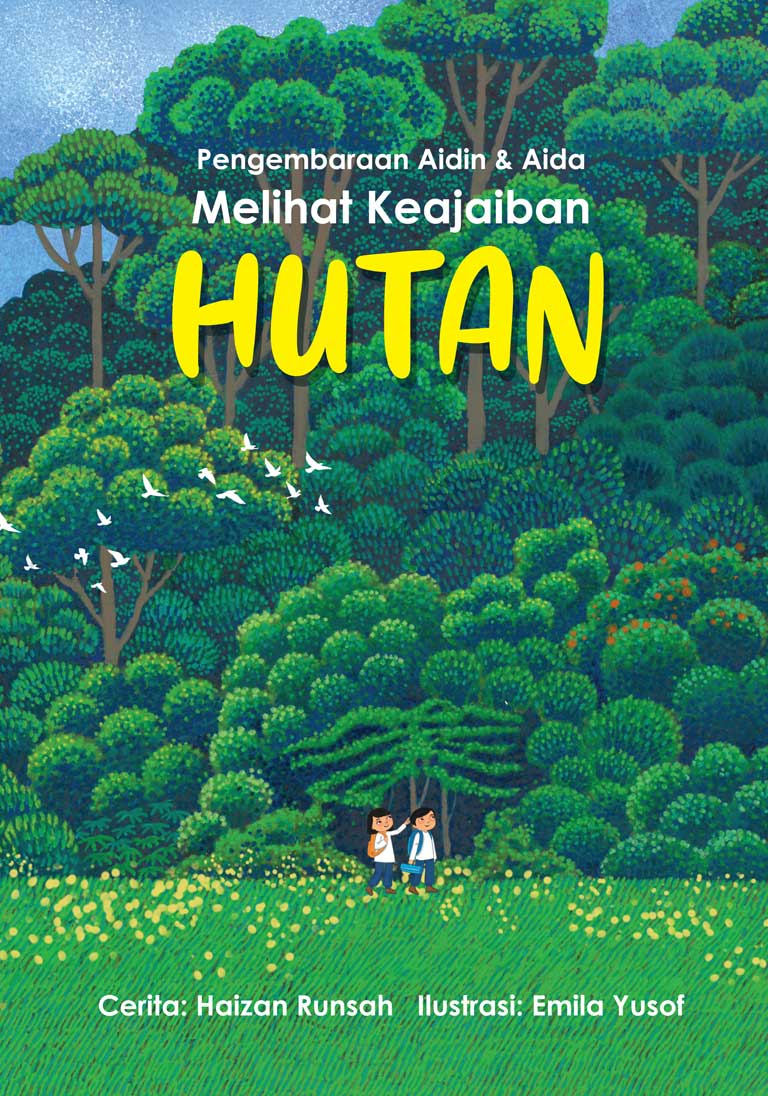
Menurut penulis, buku ini bukan bertujuan mengajak kanak-kanak mengembara ke dalam hutan. Objektif buku ini kepada kanak-kanak ialah:
- Menghargai dan menjaga hutan agar tidak pupus.
- Menambahkan pengetahuan tentang haiwan dan tumbuhan hutan.
- Memaparkan keindahan dan ketenangan yang terdapat di dalam hutan.
- Mengaitkan keindahan hutan dengan kebesaran Tuhan yang menciptakan alam.
Gambar dan cerita yang ditunjukkan adalah berbentuk umum. Menjadi tugas ibu dan bapa, para guru dan pembaca dewasa untuk berbual dan menceritakan lebih terperinci dengan ayat yang mudah difahami kepada kanak-kanak.
Buku ini dalam proses untuk mendapatkan ISBN dan PDP dari Perpustakaan Negara Malaysia. Nantikan ya!
***
English translation
The Adventure of Aidin and Aida: Exploring the Wonders of the Forest, written by Haizan Runsah
This year, I decided to take on only one illustration project from the author. Handling just that one job was sufficient for me, as I had a lot on my plate with various personal painting projects—ranging from fine art pieces to illustrations for my books. I couldn’t turn down Mr. Haizan’s invitation, especially since the theme was centred around the forest, something I have a great fondness for.
According to the author, this book does not aim to take children on a journey into the forest. The objectives of this book for children are:
- Appreciating and preserving the forest to prevent its disappearance.
- Increasing knowledge about the animals and plants in the forest.
- Presenting the beauty and tranquillity found within the forest.
- Connecting the beauty of the forest with the greatness of God who created nature.
The pictures and stories presented are general. It is the responsibility of parents, teachers, and adult readers to discuss and tell more detailed stories in language that is easily understood by children.
This book is in the process of obtaining an ISBN and PDP from the National Library of Malaysia. Stay tuned!
-
Unveiling the Art of Becoming a Children’s Picture Book Author and Illustrator
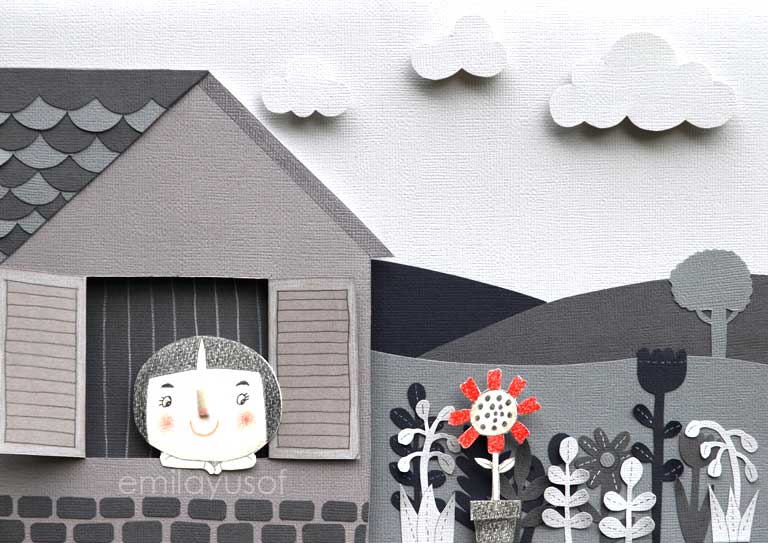
Daydream by Emila Yusof, 2018 (unpublished) Embarking on the journey to become a children’s picture book author and illustrator is a creative odyssey that combines storytelling finesse with artistic prowess. Whether you’re drawn to the enchanting world of whimsical narratives or captivated by the allure of vibrant illustrations, the path to crafting picture-perfect stories for young readers involves a blend of creativity, skill development, and unwavering persistence.
The Art of Writing:
- Understand the Audience: Before putting pen to paper, take the time to understand the dynamic audience you’re catering to. Delve into the intricacies of the chosen age group, considering their interests, language proficiency, and developmental stage.
- Read Extensively: Immerse yourself in the world of children’s literature. Read a diverse array of children’s books to grasp different styles, genres, and storytelling techniques that resonate with young readers.
- Develop a Unique Voice: Discovering your unique writing voice is pivotal. Aim to create a narrative that not only engages but also captivates young minds. Your distinctive voice is what will set your stories apart.
- Craft a Compelling Story: Craft a narrative that boasts strong characters, a clear plot, and a relatable theme. Children’s books often convey a lesson or message, so weave these elements seamlessly into your storytelling.
- Consider Picture Book Structure: Understanding the structure of a picture book is crucial. With a limited number of pages, you must master the art of crafting a beginning, middle, and end, leaving ample room for illustrations to complement the text.
The Craft of Illustrating:
- Develop Your Art Skills: Artistic prowess is the cornerstone of being a children’s book illustrator. Dedicate time to honing your skills, experimenting with various styles, and discovering the visual language that complements your storytelling.
- Understand Page Layout: Picture books demand a keen understanding of page composition and layout. The marriage of text and illustrations should create a seamless and visually compelling reading experience.
- Create a Portfolio: Compile a portfolio showcasing your best work. This portfolio will serve as your visual resume when approaching publishers or literary agents, offering a glimpse into your artistic style and storytelling capabilities.
- Consider Your Artistic Style: Developing a consistent artistic style is paramount. Your illustrations should harmonize with your writing, creating a cohesive and visually appealing narrative for young readers.
Getting Published:
- Research Publishers: Explore publishers specializing in children’s books. Thoroughly research their submission guidelines and tailor your submissions to align with their preferences.
- Consider an Agent: While not obligatory, having a literary agent can be advantageous. Agents possess industry knowledge and can assist in navigating the complex landscape of the publishing world.
- Submit Your Manuscript/Illustrations: Follow submission guidelines meticulously. Some publishers may prefer to review the manuscript first, while others may request a combination of text and illustrations.
- Be Persistent: Rejections are an inherent part of the publishing journey. Use each rejection as an opportunity to refine your work and approach. Persistence and resilience are key attributes on this path.
Marketing and Promotion:
- Build an Online Presence: Create a website or leverage social media platforms to showcase your work. An online presence enables you to connect with your audience and build anticipation for your upcoming releases.
- Engage with the Community: Participate in book events, connect with educators, and librarians, and immerse yourself in the vibrant children’s literature community. Building connections is essential for fostering support and expanding your reach.
- Consider Self-Publishing: If the traditional publishing route proves challenging, explore the option of self-publishing. It provides autonomy but demands a strategic approach to marketing and distribution.
Embarking on the journey to become a children’s picture book author and illustrator requires dedication, continuous learning, and a profound love for storytelling. As you navigate the creative process, relish in the joy of bringing imaginative worlds to life for the delight of young readers. Keep refining your craft, stay persistent, and savour every moment of the enchanting adventure that lies ahead.
-
Mila by Emila
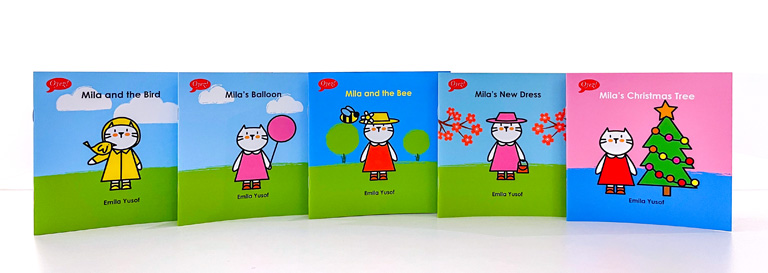
The Mila Series is available now! Embark on enchanting adventures with Mila the cat in this heartwarming series of 5 books. From playful encounters with bees and birds to whimsical moments with balloons, dresses, and trees, join Mila on a journey of joy and discovery. Perfect for young readers, each book is a delightful chapter in Mila’s tales—filled with imagination, and the magic of everyday wonders. #milabyemila
Size: 6 in x 6 in
Pages: 12 including covers
Colour: full
Publisher: Oyez!BooksAvailable at the Museum of Picture Book Art physical store (Level 1, GMBB, Jalan Robertson, KL) and my online shopee shop.